THE LARMANJAT SYSTEM
The Larmajat monorail sysytem had one centre rail. The locomotive driving wheels ran on outside paved strips, with most of the weight on the rail.
J. Larmanjat was born in Huriel, France, on 4th March 1826. His invention was first shown at the Paris Universal Exposition of 1867.
The essential idea was that most of the locomotive's weight would be carried on the rail wheels, allowing it to be moved with the usual low friction of railway operation, while the outer driving wheels provided balance and propulsion. The dreadful flaw in this is that that the driving wheels needed weight on them to get adhesion on the ground. It was therefore necessary to have a means for adjusting the weight distribution according to need as the locomotive moved along tracks of varying gradients. This was a fearful bodge and it is surprising that the idea ever got off the ground at all.
The carriages worked in a similiar fashion, most of the weight being on two central rail wheels while two side wheels held the carriage upright. This is more practical as the side wheels did not require adhesion.
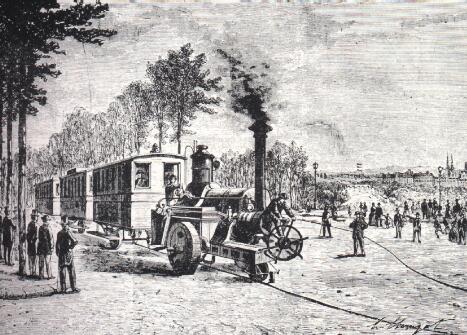 |
| Left: The first Larmanjat line with a 1-2-1 locomotive.
This line opened in August 1868, running between Raincy and Montfermeil, to the north-east of Paris. It was sharply curved. By November 1869 it was closed.
The large spoked wheel at the front looks very much like a steering wheel, complete with full-time helmsman, suggesting that the single little wheel on the front could not be trusted to get the locomotive around curves without a bit of help. This is not true. The spoked wheel actually varied the way the locomotive's weight was distributed between the two wheels on the rail and the driving wheels on the ground. This was done by moving the front wheel back and forth on inclined guides- hence the angle of the control wheel. Only the front rail wheel is visible in this view.
Notice there seems to be a sort of hump on top of the boiler; possibly some variation on the double-bass boiler.
|
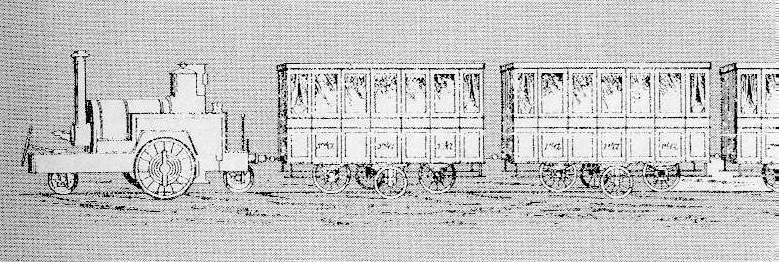 |
| Left: A drawing of a French Larmanjat train showing the 1-2-1 wheel arrangement on the coaches
The rear rail wheel can now be seen at the back of the locomotive. No sign of a boiler hump.
|
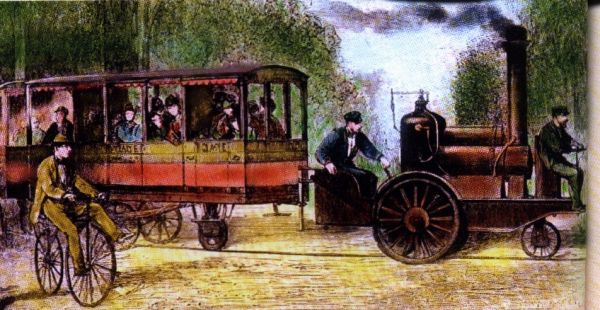 |
| Left: Another picture of the French Larmanjat train
The artist has omitted the rear rail wheel. The ship's wheel at the front has been replaced by something like a motorcar steering wheel, (many years before motorcars existed) but its function was still control of the weight distribution, not steering.
Note the unusual manning arrangements; one man had to stoke as well as drive, while the chap at the front had a full-time job adjusting the weight distribution.
|
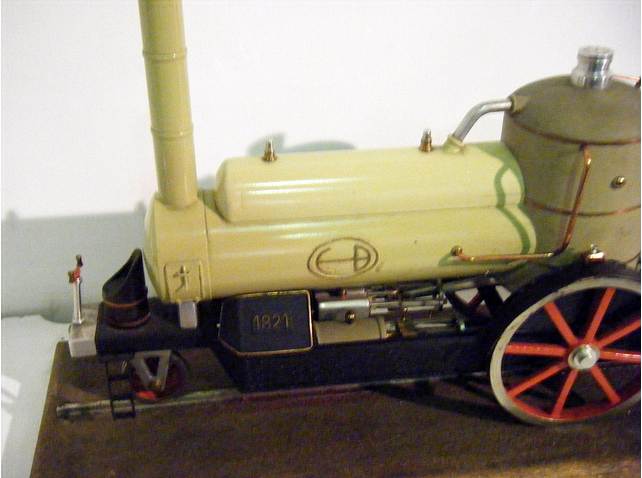 |
| Left: Model of Larmanjat locomotive
In the Warsaw Railway Museum. Note the large hump on top of the boiler
It looks to me as if this is a steamable model, judging by the size of the tubing, so perhaps we should not expect too much accuracy. On the other hand, the shape of the chair at the front looks accurate.
Note the locomotive is numbered 1821; the significance of this is currently unknown.
Author's photograph 2015
|
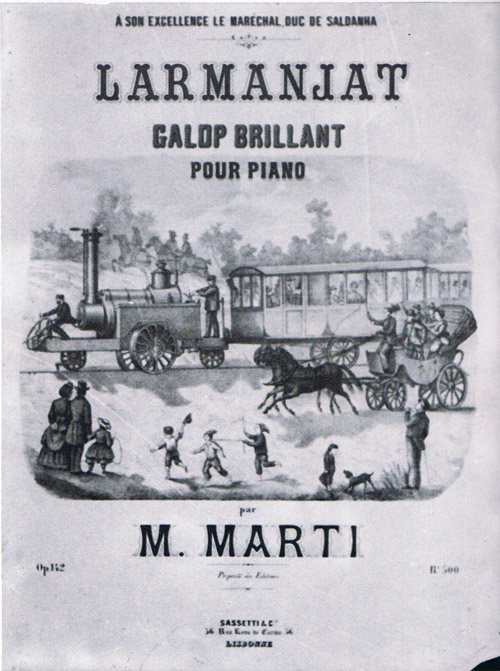 |
| Left: The Larmanjat Galop
Clearly the Larmanjat idea had a certain fashionable vogue.
|
 |
|
Above: The Larmanjat line between Raincy and Montfermeil: 1869
The route is as reported in the Annales Industrielles, Vol 2, 4 April 1870 and 20 April 1870. The line was laid with the single rail having a weight of 25.5 lb/yd, alongside the road between Raincy and Montfermeil, probably what is now the D117. According to French wikipedia the route appears to have been obliterated in the Franco-Prussian War of 1870-71. Modern maps of the area show no railway lines at all.
|
THE LISBON TRAMWAY
The apparent success of the Raincy trials, and further demonstrations in Paris in the summer of 1872, led to the formation of a British company to build a Larmanjat railway in Portugal, from Lisbon to Cintra, and from Lisbon to Torres Vedras. The latter name is famous in the history of the Napoleonic wars because of the Lines of Torres Vedras.
Lisbon (Lisboa to those who actually live there) is the capital of Portugal.
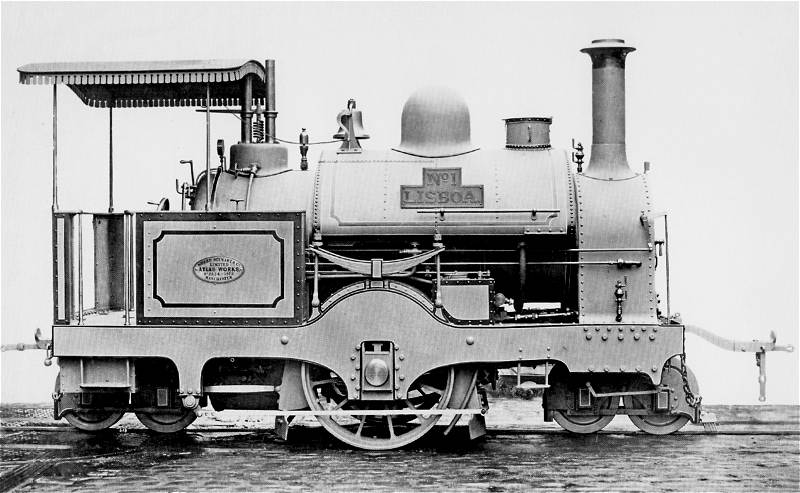 |
|
Above: The Lisbon Steam Tramway 1-1-2-1-1 Locomotive
This remarkable locomotive on the Larmanjat principle was built by Sharp, Stewart and Company for the Lisbon Steam Tramway system, which opened on 4 Sept 1873.
|
Sizteen of these locomotives were delivered in 1872. The locomotives and carriages were built by Sharp Stewart to the specification of the Lisbon Steam Tramway Company's engineer, F H Trevithick, a grandson of the great Richard Trevithick. F H Trevithick went on to be chief mechanical engineer of the Egyptian State Railways from 1883 to 1912, and more of his work can be seen in the Strange Chimneys gallery of the Museum.
There was no weight adjustment wheel. The height of the front bogie was altered by a hydraulic ram; a hydraulic pump worked from the valve motion pushed the front bogie downwards, its movement being controlled by a bleed valve in the cab. This was a considerable advance on having some poor fellow balanced on the front of the locomotive. The thing sticking out at the front is just a coupling, not some sort of guidance system for the front bogie.
The two inside cylinders were 11" x 18"; the outside road wheels were 3' 9" in diameter, and there was also a rail wheel of the same diameter in the centre of the axle. The road wheels appear to be smooth which at once raises questions about the amount of traction they could produce. The two small wheels at each end ran on the central guiding rail; they were double-flanged to keep them in place.
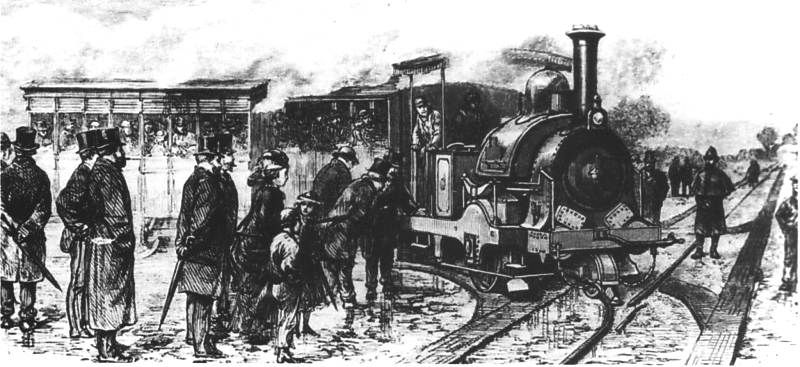 |
|
Above: A Lisbon Steam Tramway locomotive on test in England: January 1873
This is a commendably accurate rendition of the works photograph above.
A Sharp, Stewart engine was tested on a 1710 ft long tramway laid in the Epping Forest, at Buckhurst Hill, in November 1871. Since the company was based in Manchester at the time, why they decided to do their testing in South-East England is puzzling. The test tramway was on an incline for almost all its length, and had gradients up to 1 in 18.75, the average being 1 in 22.75. This would be very steep for a conventional steam locomotive.
The test track consisted of a single central rail, flanked on either side at a distance of 20 inches with longitudinal baulks of timber, on which ran the flangeless driving wheels; it was reported that these were 1 ft 2 in wide, while the timber baulks were 9 in wide. The picture however indicates that these dimensions were interchanged in error, and the wheels were actually narrower than the timber baulks. In the picture the engine has reached a T-junction, and is making a very sharp right-hand turn.
Only one locomotive was tested; No 2, called "Cintra", which cost £1500, and weighed 13 tons loaded. It hauled one 2nd and one 3rd class coach (18 passengers each) and a goods van. (These were built by Brown & Marshalls of Birmingham) Passengers entered at the sides and were seated back-to back. Speeds of up to 20 mph were reached, though the intended speed in Portugese operation was only 12 mph.
There was a demonstration run for the board of directors on 28th December 1872, and further trials were held on 3rd January 1873. This time wet weather on the previous day led to the locomotive having problems with lack of adhesion, and it is possible the directors attending went home in a thoughtful mood.
Info kindly provided by Matt Davis. The original source is believed to be Engineering for 10 January 1873.
|
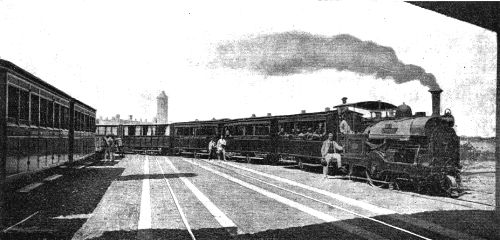 |
| Left: A Sharp, Stewart 1-1-2-1-1 Larmanjat in use
Note the single rail with a paved strip each side in the foreground.
Location and date of photo unknown.
|
The Lisbon Steam Tramway was an operational disaster. As foreshadowed in Britain, the road wheels were often unable to get enough adhesion on the steep gradients on the line. Difficulties with controlling the hydraulic weight-distribution led to frequent derailments. The uncomfortable ride and accomodation deterrred passengers and the line appears to have closed on 8th April 1875.
That however was not the end of the story. The shareholders became suspicious that the company had issued a fraudulent prospectus, and legal action followed. There was even a a legal case in Hobart, Tasmania, which alleged the issuing a fraudulent prospectus for the Lisbon Steam Tramway Company Limited. See The Mercury, Tuesday 8th August 1876. The legal ramifications in Britain rumbled on until at least 1894. Any Dayton criminal defense attorney can tell you that fraud is a serious crime which has severe penalties including restitution and incarceration.

















